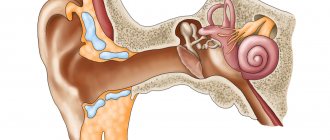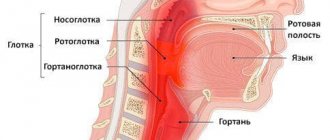Palatine tonsils and the formation of purulent plugs on them
When bacteria or viruses enter the oral cavity, local immunity is activated and leukocytes and antibodies move to the “accident site” to destroy foreign particles.
At the same time, an inflammatory process begins, in which plugs in the throat are a fairly common occurrence. Tonsillitis or inflammation of the tonsils can be either acute or chronic. The acute course of the disease is known as tonsillitis. The chronic course of the pathology is replaced by periods of exacerbation and remission, gradually turning into a sluggish, relapsing state. It is in this case that purulent plugs most often form in the tonsils.
Their formation is associated with the structure of the tonsils, which have winding canals and openings, or in other words, these are lacunae of the tonsils and crypts, of which there can be several dozen . They are not always clearly visible, since they are hidden by folds of the mucous epithelium. This is where purulent (caseous) plugs form.
Purulent plugs are a characteristic symptom of chronic tonsillitis, and more specifically, lacunar or follicular tonsillitis. Purulent varieties of sore throat can develop simultaneously, aggravating the nature of the disease.
A wide variety of microorganisms invade the tonsil tissue: bacteria, fungi, viruses. Among bacteria, streptococcus and staphylococcus are most often found on the mucous membrane of the tonsils; among viruses, the causative agents of infectious mononucleosis, acute respiratory viral infections, and herpevirus sore throats are “leading.”
How are plugs on the tonsils formed? The process looks like this:
- When infectious agents enter the tonsil mucosa, leukocytes rush to the affected area and the inflammatory process begins.
- Since pathogenic microflora accumulates in the gaps, this is where it is destroyed. Dead white blood cells and microbes are removed from the tonsils (phlegm or mucus is coughed up).
- But with edema, self-cleaning does not occur, since the entrance from the holes in the mucous membrane of the tonsils is closed.
- Dead cells (pus) begin to accumulate in the lacunae of the tonsils and purulent-caseous formations appear, which are visible as white dots (spots) on the tonsils.
If an adult or child often suffers from a sore throat, which gradually becomes chronic, then the help of an ENT doctor cannot be avoided, since without treatment of purulent formations there is an irreversible process of destruction of the tonsils.
Diagnostics
Traffic jams in themselves are not a disease, but only its consequence. It is necessary to determine the causes and treatment of the disease that provoked the formation of a plug in the tonsils.
You can independently detect a blockage in the tonsils by examining your own throat and comparing it with photographs showing what the blockages look like.
An otolaryngologist only needs to look at the patient's throat to make a diagnosis. The doctor will also interview the patient, paying attention to symptoms. Additionally, an ultrasound and a throat smear may be required to determine the nature of the stones in the lacunae.
The problem of congestion in the tonsils in children is solved by a pediatrician - a pediatrician or a pediatric otolaryngologist. After an examination, the doctor prescribes treatment that will help both get rid of the tonsil blockage and prevent their reoccurrence.
Why traffic jams form
When tonsillitis takes on a sluggish form, bacteria gradually accumulate in the lacunae of the tonsils, forming small colonies.
Leukocytes “work” to destroy them and the process of formation of plugs proceeds gradually and unnoticeably. This is where almond stones form over time, as compounds with calcium and magnesium accumulate. Stones in the tonsils are the most difficult to remove, since the mucous membrane is severely damaged. The causes of occurrence include the following factors:
- Chronic diseases of the nasopharynx as complications after a sore throat, if it was not fully treated or was not treated at all.
- A weak immune barrier, when the body cannot cope with the infection and inflammatory processes occur.
- Bad habits: smoking, drinking alcohol, unbalanced or insufficient nutrition, vitamin deficiency.
- The influence of environmental environmental factors: hypothermia, inhalation of polluted air, allergies to chemical substances.
- Damage to the integrity of the tonsils, which causes infection to enter the wound and a caseous plug to develop on the tonsil.
- Poor or lack of oral hygiene. In this case, bacteria are constantly in the oral cavity and without brushing the teeth, food debris remains on the tonsils, causing the formation of food plugs.
Pus accumulates on the surface of the epithelium of the tonsils for other reasons: it may be a hereditary predisposition, problems with nasal breathing, the special structure of the tonsils and a number of others.
How to recognize chronic tonsillitis
Purulent plugs in the throat are the main symptom of chronic tonsillitis. The patient feels as if a lump has formed in the throat. He experiences difficulty swallowing, which is accompanied by pain. A putrid odor occurs from the mouth, which is a consequence of the activity of bacteria.
Caseous plugs are clearly visible during visual inspection: yellowish cheesy tubercles are located on the tonsils. Abscesses may be hidden in the folds of the epithelium, but when pressed they become clearly visible. Caseosis is necrosis (death) of tissue that is affected by infection.
So, the main manifestations of sluggish tonsillitis are:
- presence of caseous plugs;
- tonsillitis, recurring 2-3 times a year;
- redness and swelling of the palatine arches, to which inflammation spreads from the tonsils;
- enlarged lymph nodes;
- a slight increase in body temperature to +37C;
- lethargy, fatigue, apathy.
Removing tonsils is not a solution to the problem. Traffic jams still form on the pharyngeal and lingual tonsils. Due to the dryness of the mucous membrane and the free penetration of infection into the body, their formation is quite possible.
It is necessary to get rid of purulent plugs, since their accumulation leads to the spread of infection through the blood and lymph, which can lead to heart disease, inflammatory processes in the joints and kidneys. The most dangerous complication of tonsillitis is an abscess or a significant accumulation of pus, which leads to general sepsis (infection) of the blood or the development of phlegmon of the neck.
How to treat purulent plugs on the tonsils
When local immunity continues to work, and the loosening of the tonsil tissue is not yet pronounced, a conservative method is used. A smear is taken from the surface of the tonsils to determine pathogenic microflora and its sensitivity to antibiotics. Treatment with these drugs is only possible for bacterial infections; in other cases, the effect of their action will be reduced to “zero”.
The most effective penicillin antibiotics are: Oxacillin, Ampicillin, Amoxicillin, Amoxiclav. If bacterial culture has not been carried out, then broad-spectrum drugs from the group of macrolides or cephalosporins are used. In some cases, antibiotics are injected directly into the tonsil area, for example, Bioparox is used.
To remove plugs, the Tonsillor device is used, which extracts pus through vacuum pumping, and then washes the tonsils with antiseptic solutions and treats them with low-frequency ultrasound. The tonsils are perfectly cleared of purulent accumulations and are reduced in size.
Manual douching of the tonsils with solutions of antibiotics, Furacillin, potassium permanganate, boric acid, Miramistin, Iodinol is also used. After clearing the tonsils of plugs, their localization sites (lacunae) are covered with special pastes. To achieve results, 10 procedures are enough. With fewer of them, relapses are possible.
To get rid of unpleasant symptoms in the throat and bad breath, the patient tries to “squeeze out” the pus on his own. But this will not bring relief, since only the surface layer is removed, and the purulent plug itself remains deep inside. In this case, the surface of the tonsils is easily injured.
Additional conservative treatment includes the following measures:
- To strengthen and strengthen the general immune system, medications are prescribed: Interferon, Immunal, Amiksin, Taktivin, echinacea tincture, injections with aloe extract.
- To support local immunity, use IRS-19 aerosol, Lysozyme, and Isofa nasal drops.
- If you have white plugs (complex problems in the body), you must take B vitamins.
- Inhalations are carried out with an isotonic solution containing phytoncides (substances with an antibacterial effect).
- Physiotherapy procedures are added: ultrasound, microcurrents, UHF, phonophoresis.
All these methods are effective and can cure chronic tonsillitis with conservative therapy. They will help cleanse the tonsils, which will further perform their main function.
Caseous plugs - conservative treatment methods
So, the source of the pathology has been identified, it’s time to begin its timely and, most importantly, effective elimination, mainly through medication. If caseous plugs have just appeared during tonsillitis, the use of local antiseptics is quite sufficient to ensure a quick recovery of the patient at any age. It is recommended to focus on the following therapeutic measures:
- The use of antibacterial solutions for gargling with minimal risk of penetration of active components of a synthetic nature into the systemic bloodstream. Particularly effective in this direction are such medications as Iodinol, boric acid, Furacilin, Miramistin. These are all solutions that should be used externally in treatment.
- Gargling with natural antiseptics , decoctions to eliminate the inflammatory process and excessive swelling. For example, it could be a chamomile decoction, but it is also possible to use an infusion of calendula, coltsfoot, and St. John's wort. Treatment is often auxiliary, but very effective.
- Before treating caseous plugs with conservative methods, care must be taken to restore the body's immune response. To do this, you will need to select a powerful immunostimulant , according to your age category. For adult patients, this may be Imudon, Polyoxidonium.
Therapeutic measures
If the disease is not identified in a timely manner, and is diagnosed with a significant delay, caseous plugs with tonsillitis require antibacterial therapy with the participation of penicillin drugs. It’s worth clarifying right away that a saline solution, even in combination with a few drops of iodine, has a mediocre effect and is not able to break through the tonsils or free them from purulent plaque. In such a clinical picture, the sequence of therapeutic measures is as follows:
How to get rid of throat congestion forever
There are two ways: to treat chronic sore throat with medication in full or resort to surgical intervention. Treatment methods in surgical practice:
- laser lacunotomy is a new procedure that involves removing plugs and “suturing” lacunae with a laser;
- Tonsillectomy is a radical method of solving the problem and involves the complete removal of the tonsils; applies in exceptional cases.
Indications for tonsillectomy are extremely severe sore throat, high incidence of the disease, periodic exacerbations, persistent caseous plugs in the throat, lack of effect with conservative therapy.
A tonsil removal kit includes a scalpel, laser, or liquid nitrogen. When preparing for surgery, the ENT doctor will explain the features of the procedure and its consequences.
Side effects from rinsing
The use of vacuum cleaning has no side effects.
Cleaning your tonsils with a cotton swab or pad may trigger the gag reflex. As a result of the spasm, vata can enter the esophagus, which will require urgent surgical attention.
The method of removing plugs by squeezing is very painful and is dangerous due to secondary infection of the tonsils, a complication.
The disadvantage of the method of cleaning the tonsils using a syringe is the possibility of injury to the tonsils during self-washing, and incomplete cleaning if the diameter of the needle is larger than the lacuna.
An allergic reaction in the form of a rash and itching is possible when rinsing the tonsils with Furacilin, Chlorophyllipt, Chlorhexidine.
Read more Blue-red spots on legs
The throat is the main barrier to harmful microorganisms. The tonsils are designed to protect the body from infection by destroying microbes. Healthy tonsils cleanse themselves of waste products. If for some reason they lose their physiological function, then bacteria accumulate in the lacunae. They contribute to the formation of so-called caseous plugs.
Treatment at home
In the treatment of chronic sore throat at home, in addition to medications, a variety of rinses are used, among which traditional medicine is widely used. Use:
- Chamomile infusion, which is a good antiseptic.
- Hot tea with the addition of lemon and black currant relieves sore throat and enriches the body with vitamins.
- Thick propolis, which is recommended to be chewed several times a day for 2 weeks. It supports local immunity and reduces the possibility of relapses.
- A traditional remedy that includes 1 tsp. soda, 1 tsp. salt and 5-6 drops of iodine per glass of boiled water. An excellent gargle that can be used twice a day.
The recipes are simple but effective. They will not get rid of the disease, they will not help remove traffic jams, but they will significantly alleviate the condition.
Treatment of tonsillitis in children using the Komarovsky method
Children's doctor Evgeniy Komarovsky claims that with systemic therapy, conservative treatment twice a year during periods of colds is sufficient.
In a child, the infection develops quite quickly and if its nature is bacterial, then antibiotics cannot be avoided. A preliminary culture is carried out and the source of infection is determined. In case of a “viral attack,” it makes no sense to treat with medications.
Dr. Komarovsky opposes the use of antiseptics for treating tonsils, considering these products to be useless. He especially does not recommend Lugol's solution, which contains iodine and can affect the functioning of the thyroid gland.
All efforts should be aimed at strengthening local immunity. It is very important that the mucous membranes are constantly moist and the saliva does not dry out. For this:
- visit the dentist and have your oral cavity sanitized;
- Make sure your child drinks warm drinks as much as possible;
- adjust the microclimate in the apartment: t=+18-20C, air humidity – 50-70%;
- in the baby’s room there should be a minimum of things on which dust containing infectious agents can accumulate;
- stay in the fresh air as often as possible;
- Do not treat children's clothing with household chemicals containing chlorine.
All these measures will help minimize the occurrence of tonsillitis and, even more so, its transition to the chronic stage. If the child is already sick, then comfortable conditions will contribute to a quick recovery.
Chronic tonsillitis and throat congestion are not a death sentence, but an inability to maintain your defenses at the proper level. Modern medicine copes well with the disease. It is important that the treatment is structured competently and completed.
Caseous plugs - potential complications
The most common complications of untreated sore throat and delay in surgical intervention are chronic tonsillitis and persistent low-grade fever with caseous plugs. Both diseases are unpleasant, disrupt breathing, reduce the quality of sleep, and cause frequent dizziness. They are prone to systematic relapses, and the tonsils even become the weak point of the clinical patient.
However, in reality everything can turn out to be much more serious. Because the pathogenic infection predominates and gradually spreads in the body. If it is not eliminated in a timely manner, doctors do not exclude the development of such global diagnoses as:
- pneumonia,
- heart valve prolapse,
- rheumatism of the heart or joints,
- glomerulonephritis,
- chronic allergies.
Already such diagnoses require radical measures, but are not subject to final recovery.
As a last resort, doctors in childhood suggest removing tonsils clogged with pathogenic flora. The operation is simple, but also fraught with dangerous consequences for children's health. The fact is that the body loses its natural defenses. Therefore, they are twice as likely to be susceptible to infectious diseases and inflammatory processes. The main task of the specialist is to take all possible measures to solve the growing problem in the patient’s life using conservative methods.










